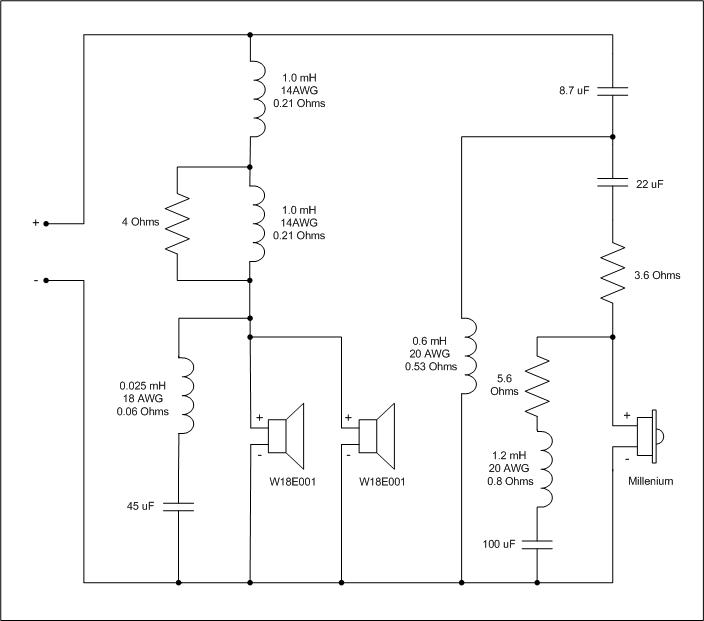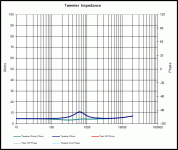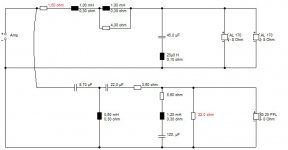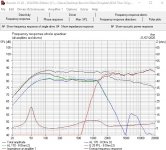mcgi said:I have the top end sounding perfect now, the only thing that I need to fix is somewhere in the middle. Not sure where exactly but singing/voices are very quiet. I’m not sure if it is the woofer or tweeter that needs adjusting. I’ve got them bi-amped so have been able to do a direct comparison with the PMC’s when driving only the woofer or only the tweeter. The PMC woofer definitely crosses over much higher, but that’s what I was expecting as I know the XO that I have is fairly low, from memory I think it was about 1500Hz. Maybe I need to do some measurements to work out what’s missing?
Quoting because I think we are turning the page here.
Maybe it's not fixable. Speakers are imperfect things by nature.
E0017-08S W18EX001
E0011-06 T25CF002
A little review. The SEAS filter around 2kHz:
Your 1.7kHz filter:
Troels Gravesen's way of doing things:
TJL-2W
I found a slight inaccuracy in the tweeter Fs correction in your filter. The notch filter is almost non-existent too. The low crossover is what US people always seem to do. Just increases tweeter distortion IMO.
I would set it up in a simulator and try and get an idea what is going on with phase and dispersion and impedance with all three filters..
Big effort. But the only way, IMO. Even using merely similar drivers would tell you a lot:
Software | Visaton
VIB 170 AL – Boxsim Projektdatenbank
I have the TJL-2W with the Fountek ribbon tweeter. Troels no longer has this version on his site and the crossover for it is less complicated then the one he uses with the dome tweeter. I feel it is an excellent implantation of the SEAS W18E001..the tone is darker but highly resolved which is unique from what I have heard from this driver. Maybe you can convince him to repost the schematic on his site.
Maybe it's not fixable. Speakers are imperfect things by nature.
A little review. The SEAS filter around 2kHz:
Imperfect they may be, but I don't see any reason why it shouldn't be fixable. It just needs designing, given that different drivers have been used. Joseph D'Appolito's (i.e. the Seas) filter for the Thor is set at 2.5KHz.
Troels Gravesen's way of doing things...
Yes, full electrical 4th order plus notches. Different baffle, driver
I found a slight inaccuracy in the tweeter Fs correction in your filter.
Attached. Dark blue using D'Appolito's measured impedance of the Millennium tweeter, teal with the aforementioned Fs LCR conjugate. Not perfect, but looks 'good enough' for purpose.
The notch filter is almost non-existent too.
Which, the 0.025mH + 45uF shunt on the midbass units? You've lost me with that one Steve, it's a bottomless notch on their primary bell mode. Very high Q, very high level of suppression since the only resistance is the inductor DCR.
The low crossover is what US people always seem to do. Just increases tweeter distortion IMO.
Only about 300Hz lower than Troels used in the example you posted. It's a balancing act between ensuring proper suppression of the midbass cone modes, and avoiding excess tweeter distortion. The Millennium is a bit of a tank and can handle low crossover frequencies in an average sized 2-way. 1.7KHz should be OK providing at least a 3rd order electrical high pass is used (to ensure excursion decreases below the XO frequency).
Big effort. But the only way, IMO. Even using merely similar drivers would tell you a lot:
I would suggest a better way to go would be to measure the system and design using that data. Still, approximate simulations using the intended drivers will help. Others -to a much more limited point as distortion behaviour is a significant factor with these units and unless you have or account for that, you're not likely to make best use of them.
Attachments
Last edited:
I just did some rough simming of the three filters.
The steep one in use here is 1.7kHz or so. Nice flattish impedance, BTW.
The shallower SEAS is 2.5kHz. Regular sort of bell-shape impedance.
Troels' 4th order is 2kHz. Didn't want to spend too long on it, but looks OK.
Interestingly, IMO, the SEAS one has almost 3dB more midrange energy between 200 and 2kHz. Or the other one is bass heavier.
That sounds like what mcgi is hearing. 😎
The steep one in use here is 1.7kHz or so. Nice flattish impedance, BTW.
The shallower SEAS is 2.5kHz. Regular sort of bell-shape impedance.
Troels' 4th order is 2kHz. Didn't want to spend too long on it, but looks OK.
Interestingly, IMO, the SEAS one has almost 3dB more midrange energy between 200 and 2kHz. Or the other one is bass heavier.
That sounds like what mcgi is hearing. 😎
I have the top end sounding perfect now, the only thing that I need to fix is somewhere in the middle.
In my opinion an additional 1 ohm resistor is urgently needed at the input of the woofer filter in order to improve the frequency response of the woofers. Then adjust the tweeter level to your liking.

I just did some rough simming of the three filters.
The steep one in use here is 1.7kHz or so. Nice flattish impedance, BTW.
The shallower SEAS is 2.5kHz. Regular sort of bell-shape impedance.
Troels' 4th order is 2kHz. Didn't want to spend too long on it, but looks OK.
Yes, all of those are stated in the respective pages / documentation, so it sounds like you've got the transfer functions nicely consistent. 🙂
Interestingly, IMO, the SEAS one has almost 3dB more midrange energy between 200 and 2kHz. Or the other one is bass heavier.
That sounds like what mcgi is hearing. 😎
Possibly. Thor was designed by D'Appolito (the Seas filter is D'Appolito's) to be flat on [tweeter] axis at 1.25m or > for proper summing, with 4th order acoustical slopes, and measures that way in his data; if memory serves the alternate filter has a slightly declining response trend along roughly B&K lines. In this case, I suspect more of a problem lies in the fact that it's not using the midbass drivers the speaker was designed for, and without compensating for both the lower Q and the increased sensitivity of the EX001, the balance will be thrown out by several dB through the midband, nor will the enclosure loading be optimal. Being an Augspurger type TL, the Thor was not a high-output line design in the first place, so with overdamped drivers and potentially inadequate compensation for the balance above mass-corner, there are going to be issues. Unfortunately based on the Seas data you'd need about 5ohms series R to artificially increase the EX001's effective Qts up to the 0.42 of the E001 the Thor enclosure was designed for, but that will reduce overall sensitivity to a level lower than that unit, so the tweeter is likely to need more padding to get the overall response into line.
Last edited:
In my opinion an additional 1 ohm resistor is urgently needed at the input of the woofer filter in order to improve the frequency response of the woofers. Then adjust the tweeter level to your liking.
Scottmoose, with respect, you took your eye off the ball there. 😱
I just tried Dissi's idea on my simulator. It works brilliantly. Maybe I'd try 1.5R and 20W Because Amplifier power is cheap so we can waste it. Even improves impedance. What's not to like?
Well, the fact that the EX001 drive units, even with 1ohm - 1.5ohm series R are still significantly over-damped relative to the E001 springs to mind. 😉 While it will help to a point though the midband, the mass-corner frequency will still be raised, with output reduced below that relative to the E001 the Thor was designed for; an effective Qt of 0.29 (1ohm) - 0.32 (1.5ohm) plays against 0.42. And some found the overall balance of the Thor a little bright to start with due to its well-damped LF characteristic, so if you have even more LF damping, it will push the overall balance even further that way.
I don't think so.
The Thor actually was designed for a Qts of 0.34 (W18E001, old datasheet) and the W18EX001 with a series resistor of 2 ohms (1 ohm for two drivers wired in parallel) has a Qts of 0.33. That's pretty close, isn't it? 🙂
The Thor actually was designed for a Qts of 0.34 (W18E001, old datasheet) and the W18EX001 with a series resistor of 2 ohms (1 ohm for two drivers wired in parallel) has a Qts of 0.33. That's pretty close, isn't it? 🙂
I stand corrected, yes. I forgot they changed the datasheet. That'll teach me not to check my records. However, it seems we all agree that the EX units require series R or it's flat not going to work (notwithstanding my error re the necessary quantity due to overlooking the datasheet change).
Last edited:
Slightly low Qts is not the end of the world. If the original design had damping
material directly behind the woofers remove that and it will help.
I don't think he's having bass problems at this point anyway.
material directly behind the woofers remove that and it will help.
I don't think he's having bass problems at this point anyway.
Agreed, and probably not excessively so; it can throw the overall balance out though so worth at least keeping in mind given that Thor as-designed uses a well-damped TL alignment. You can also bring the LF levels up by pulling some damping from the last few inches of the line. As noted however, I overlooked the fact that the data sheets have changed over the years since I last looked at it; the difference in practice isn't massive though and relatively easily compensated with the modest series R Dissi refers to that also helps with midrange level-matching.
Last edited:
The room and placement is going to have the largest effect on bass, I don't see the point of obsessing over the minutiae of the speaker's bass response TBH.
Let's take it from the top:
Two things I know about this Forum.
Firstly: Never, ever, argue with Pano. El Jefe, Head Honcho in our room.
How do I know this? Because, Secondly, Dissi told me.
I was launching into a mistaken ramble about one of Pano's designs. TBH, I got it so wrong, Misunderstanding woofer inductance at the time. Dissi saved me.
Clearly the room could do with improvement here:

An ohm sounds like nothing. But 3dB of midrange presence is a lot. I consider the Thor speaker problem solved.
In my opinion an additional 1 ohm resistor is urgently needed at the input of the woofer filter in order to improve the frequency response of the woofers. Then adjust the tweeter level to your liking.
Two things I know about this Forum.
Firstly: Never, ever, argue with Pano. El Jefe, Head Honcho in our room.
How do I know this? Because, Secondly, Dissi told me.
I was launching into a mistaken ramble about one of Pano's designs. TBH, I got it so wrong, Misunderstanding woofer inductance at the time. Dissi saved me.
Clearly the room could do with improvement here:
An ohm sounds like nothing. But 3dB of midrange presence is a lot. I consider the Thor speaker problem solved.
The room and placement is going to have the largest effect on bass, I don't see the point of obsessing over the minutiae of the speaker's bass response TBH.
Absolutely; that they usually do. Unfortunately, if you don't know much about the Thor's background, it's not entirely minutiae for some of its builders. My suspicion is that part of that was due to mismatched expectations, but there are factors in the design that make it a little more 'involved' than some. It's another of the reasons it's had so much debate over the years.
Without going to excessive lengths, Thor is derived from Augspurger's [extended system] alignments, but that comes with a few caveats. Firstly, it mixes & matches two different variations, the offset driver & the tapered line, so the line length & offset are in fact a hybrid. Secondly, for perfectly reasonable practical purposes, Joe had to reduce Vb by about 1/3 from that specified under the Augspurger alignments. As damped & built, the loss and the lower tuning frequency didn't affect things terribly in terms of the stated intended F3 but it limited flexibility for driver & damping variations etc. For some this was also compounded by the fact that they may not have appreciated in advance what type of line it is. Augspurger & D'Appolito were after well (approaching critically) damped alignments, especially with the extended types, and Thor is akin in bald FR to a sealed box alignment lurking around the Qtc = 0.55 region (per the original writeup). And that's not what everybody who sees the term 'TL' necessarily thinks, especially around 2000 when Thor was designed and TL variations were rarer, most of those people had experience with being higher gain types a la IMF designs. Combine these two aspects and you got some disappointment with the LF loading, which is reasonable if (if) trimmed out right, positioned suitably (as you point out) and you're not necessarily expecting to shake the foundations of the house across the street.
I've said it before, but I'll repeat it here: I like the Thor in many ways, not least because the debate surrounding both enclosure and XO gets people interested. No bad thing in this hobby. It's a strange design in that when working with it, mistakes keep cropping up -not necessarily in the Thor itself, but in people's analysis. Not least mine -I overlooked the datasheet change for instance. And the Fat Thor I did 15+ years ago for some who were fighting to get some more LF to give another example. Well, it does do that, so I'm not complaining. But I certainly wouldn't do it like that now. And so on. I'm not sure there's ever been a DIY 2-way project that's generated quite so much attention as Thor, and continues to do so 20 years after it was developed.
Last edited:
Gents, thanks for all your replies. I feel like I throw a hand grenade in and they you all explode with discussion. Obviously I’m a complete novice but I have to say that they do sound absolutely magical, by far the best speaker I’ve ever experienced in terms of soundstage and clarity, even with my midrange issues and the room limitations. And 4 friends who have listened to them agree that they sound great (they would say that, wouldn’t they..). The bass output is perfect, really deep and my friends don’t believe me that I haven’t got a subwoofer hidden somewhere. I think the position in a corner for the left speaker helps, but also the fact that I’ve only got 150g of wool in the first half of the TL and nothing in the second half. It really feels to me that a little tweak to lift something in the mids would transform them, but not by much as it might be too much for my room. Speaking of which, I have no clue what anybody is suggesting or if there is a consensus?
It is difficult to figure out your midrange issue without a more detailed description.
Is the issue in the midbass that provides warmth and body to vocals, or is it the
upper midrange where we hear most consonant sounds, ssss for example?
If you need more sss then you probably want to bring up the bottom of the
tweeter range, if just a bit lower bring up the top end of the woofers for more
1 ish KHz. Or both?
A DSP EQ might be a simple way to figure out what you need.
Is the issue in the midbass that provides warmth and body to vocals, or is it the
upper midrange where we hear most consonant sounds, ssss for example?
If you need more sss then you probably want to bring up the bottom of the
tweeter range, if just a bit lower bring up the top end of the woofers for more
1 ish KHz. Or both?
A DSP EQ might be a simple way to figure out what you need.
This Thor speaker has baffled a lot of people for too many years. Something wrong with it, but nobody has quite figured it out. 😕
This is your current crossover, mcgi. Some doubt in my mind if the notches are strictly correct, but if it ain't broke don't fix it:
L-C Resonance Calculator - Pad2Pad

Dissi is far better and more exact at this sort of thing than me, but I would go a bit further and try 1.5R. Maybe 20W rating. Then adjust tweeter level to taste. Some of my rough modelling added. Yeah, I know. And I got the 120uF wrong. But it makes sense to me... 😱
This is your current crossover, mcgi. Some doubt in my mind if the notches are strictly correct, but if it ain't broke don't fix it:
L-C Resonance Calculator - Pad2Pad
In my opinion an additional 1 ohm resistor is urgently needed at the input of the woofer filter in order to improve the frequency response of the woofers. Then adjust the tweeter level to your liking.
Dissi is far better and more exact at this sort of thing than me, but I would go a bit further and try 1.5R. Maybe 20W rating. Then adjust tweeter level to taste. Some of my rough modelling added. Yeah, I know. And I got the 120uF wrong. But it makes sense to me... 😱
Attachments
PB2; it is the mid bass and you hit the nail on the head about the warmth and body-I wouldn’t say it is missing, just too low. The best way I can describe it is that the vocals feel like they are in the ‘background’ of the music. I listen to a lot of electronic music without too many vocals and only really notice it when listening to a track with vocals.
System7; thanks. Where exactly in the circuit do I place the resistor?
System7; thanks. Where exactly in the circuit do I place the resistor?
- Home
- Loudspeakers
- Multi-Way
- Thor speaker – lots of help needed please!


